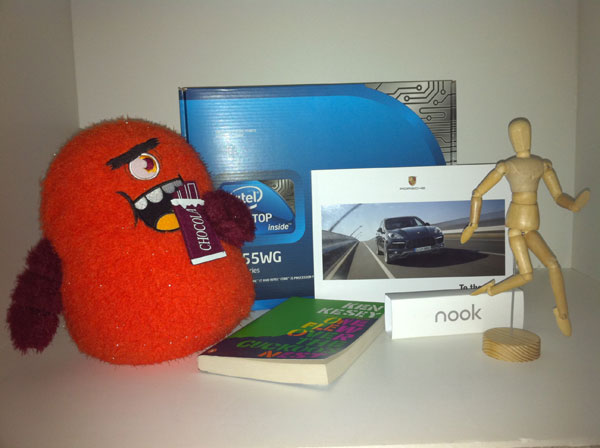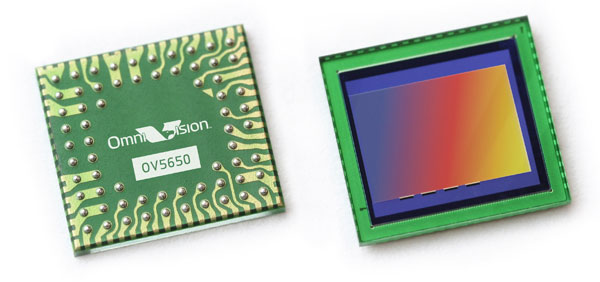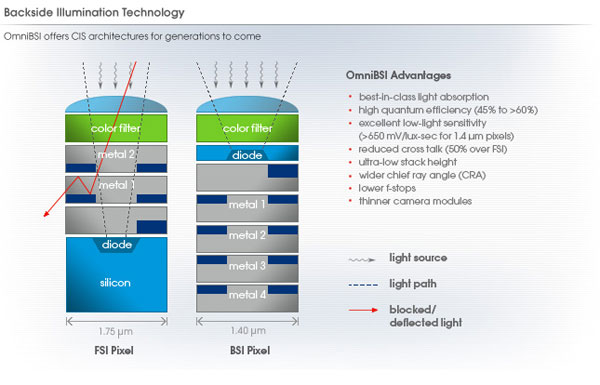Apple's iPhone 4: Thoroughly Reviewed
by Brian Klug & Anand Lal Shimpi on June 30, 2010 4:06 AM EST- Posted in
- Smartphones
- Apple
- iPhone 4
- Gadgets
- Mobile
Welcome to 2010, Apple Upgrades its Camera
The iPhone 4 is equipped with two cameras: a 5 megapixel camera with LED flash on the back of the phone and a VGA camera with no flash on the front. The LED flash works in both still and video modes. Like the EVO 4G, the iPhone 4‘s flash allows you to shoot in perfect darkness. If you’re filming a video in low light the LED will stay illuminated while you’re recording.

Taken with the iPhone 4 in total darkness
The same unfortunately can’t be said for the front facing camera on the 4. In anything but good lighting you’re going to get noise. It’s really only useful for FaceTime (or as an alternative to a mirror) and even then you need to be well lit for it to look decent.
Apple has opted for a 5 megapixel OmniVision sensor for the rear camera on the iPhone 4. What's interesting is that Apple has decided to bring backside illumination front and center with their marketing.
Backside illumination improves the sensitivity of CMOS and CCD detectors by reducing the amount of material in the path of incident light. In a frontside illuminated detector, a considerable amount of light is lost due to absorption that doesn't result in emission of an electron, in addition to reflection off pixel structures and electrical components near the frontside surface. Backside illumination greatly improves sensitivity by flipping the stack over. Instead of light having to pass through and possibly be reflected by metal structures, it is converted into electrons and read out by passing solely through silicon. Creating a backside illuminated part isn't as simple as flipping a sensor over, however, as manufacturers also generally thin the silicon light has to pass through before it can reach the photodiode. This further improves sensitivity and is generally accomplished through chemical etching in acid or by lapping (physically grinding) sensors at wafer scale.

OmniVision OV5650 - iPhone 4's rear camera SoC
Though backside illumination (BSI) improves quantum efficiency (how many photons are converted into electons), backside illumination is hugely important for another serious reason as well. Because the sensor is small at 4.6 mm by 3.4 mm, pixel size is also extremely small at just 1.75 microns square for the OV5650 in the iPhone 4 (state of the art sensors are 1.4 microns square, like those in the HTC Incredible's 8 MP sensor). Frontside illuminated parts generally have in the neighborhood of 10-15 microns of silicon before the active region of the photodiode where one wants photons to get converted to electrons. The result is that without backside illumination, pixels have a 10:1 ratio of height to length, you can visualize them as looking something like long square pillars. But that's a problem.
As photons are converted into electrons in that silicon, there's no guarantee that it will immediately travel down into the gate structure below to be read out by the camera. Electrons drift as they descend these columns, meaning that photons incident on one pixel don't necessarily map to the gate below. Because the smartphone camera sensors are so small, with a 10:1 ratio of height to size, the result is large amounts of so-called quantum blurring from electrons traveling into the gate structures of adjacent pixels. The result is a blurry image (and a decrease in MTF at the sensor level!), thus not representing the image that used to be incident on the sensor.
OmniVision and other smartphone CMOS sensor manufacturers thin that column down in an effort to come closer to having the pixel look more like a cube than a huge pillar. Ballpark numbers are between 3 and 6 microns, down from 10-15. The result is much more sensitive sensors that are higher resolution. While megapixels don't necessarily matter, neither does pixel size as much anymore; it's all about quantum efficiency, which is what engineers really care about.

OmniVision BSI - Courtesy OmniVision
The optical system of the iPhone 4 is difficult to characterize without disassembly, though the focal length is a bit shorter than previous iPhones. The result is that the photos are demonstrably wider angle. Backside illumination also allows for a bigger chief ray angle, higher numerical aperture (and thus lower f/#), but I won't bore you with the details.










270 Comments
View All Comments
JAS - Wednesday, June 30, 2010 - link
AT&T recently upgraded its 3G network in New York City. So, the improved wireless connection experienced with the iPhone 4 might be coincidental.http://news.cnet.com/8301-1035_3-20009134-94.html
John Sawyer - Thursday, July 1, 2010 - link
You mean, "might NOT be coincidental"?John Sawyer - Thursday, July 1, 2010 - link
A very large part of the problem between ATT and the iPhone prior to model 4, has been a weird interaction between the two, rather than being due to just one or the other. I don't know which party is more to "blame" for not having addressed this problem, but since the iPhone 4, and non-iPhones, experience much fewer problems with ATT's signal, I suspect Apple and the previous iPhone designs are more to blame, and ATT has allowed itself to take the brunt of it.Dennis Travis - Wednesday, June 30, 2010 - link
Another Outstanding review. So much detail. The part on the Antenna was great. Answered any questions I had about the iPhone 4.Thanks so much.
mongo lloyd - Wednesday, June 30, 2010 - link
"If you're married to Android, in the next 6 - 12 months we should see feature parity from the competition."I must be mad then, because I'd say there are Android smartphones out there that match, or even surpass the iPhone 4's features (especially software-wise), apart from battery life and the high-res screen (but the difference isn't massive between 600x960 and 480x800 or 480x854, plus you have the TFT vs (S)AMOLED pros and cons).
mongo lloyd - Wednesday, June 30, 2010 - link
It is a nice screen though, I must say.solipsism - Wednesday, June 30, 2010 - link
Buying and using nearly every new smartphone I can't say that Android beats iOS in any consumer way expect for the anemic notification system found on iOS, but while Android is pretty decent, it's still a far cry from WebOS. I haven't gotten the push for Froyo yet, have they finally fixed copy/paste on Android to?I see Android (and other) smartphones being in trouble in this next year against the iPhone 4. They will need to compete against the iPhone 4's display but at the risk of battery life, which they already do poorly in (despite the iPhone getting a bad rap). Unless Froyo has brought about some dynamic power management changes I don't think see other smartphones being as competitive as they would have been otherwise.
Spoelie - Wednesday, June 30, 2010 - link
In GSMarena's preview of iOS4, there is a whole list of features that iOS4 does not do that Android does. This is not a stab at iOS4, but it does validate the conclusions Anand makes and it proves that you can't really make blanket statements like "can't say that Android beats iOS in any consumer way". It just depends how much you value those kind of features. The list reads like this:* No Flash support in the web browser
* No true multitasking for all applications
* iOS4 for iPhone 3G has limited new feature set
* Poor performance on iPhone 3G
* No quick toggles for Wi-Fi, Bluetooth or 3G
* No social networking integration
* No info widgets on lockscreen or homescreen
* SMS tones are still not customizable
* No mass mark emails as read
* No proper file browser or access to the file system
* No USB mass storage mode
* No vibration feedback when touching the screen
* No Bluetooth file transfers to other mobile phones
* Contacts lack a swipe-to-delete or mass delete feature
* No SMS/MMS delivery notifications
* No smart dialing (but Spotlight is a somewhat of a substitute)
* No DivX or XviD video support and no official third-party application to play that
* The whole iPhone is too dependent on iTunes - you cannot add the same type of content (video, photos, apps) to the phone from two computers, a regular file management interface would have been much better
Again, not a stab at iOS4, just to point out the different markets.
FATCamaro - Wednesday, June 30, 2010 - link
I think all but 3 in your list are design choices rather than missing features. The only things that seem like features would be...* No info widgets on lockscreen or homescreen
* No SMS/MMS delivery notifications
* No mass mark emails as read
Griswold - Wednesday, June 30, 2010 - link
Theres no difference for the enduser between design choices and missing features - if it doesnt do what you want or need it to do, its not the right phone. That said, the feature set of android is much richer, but not everyone wants or needs that... apparently. Doesnt change the fact that android does beat iOs in many ways.